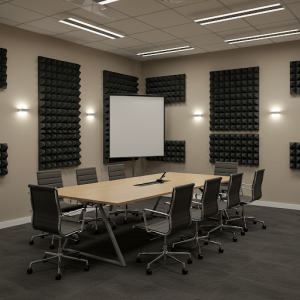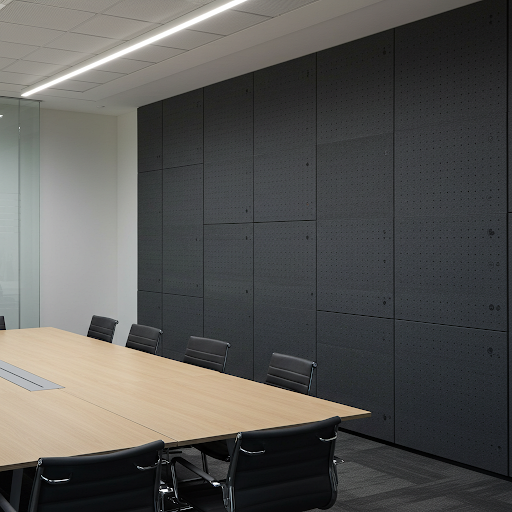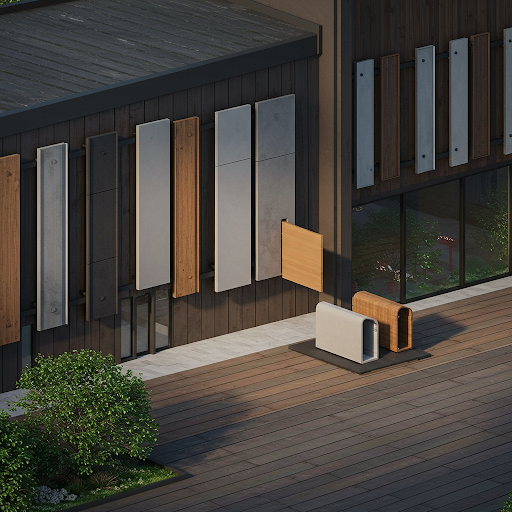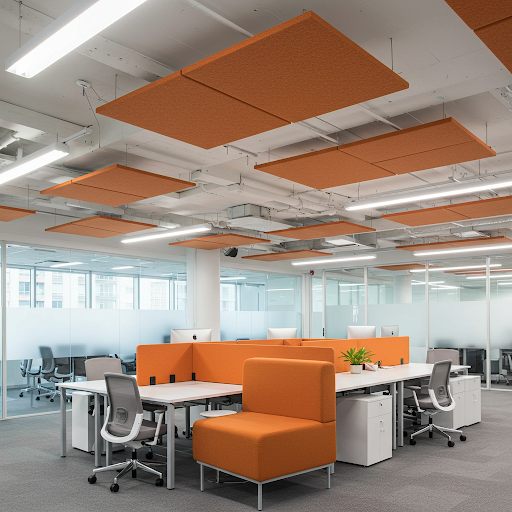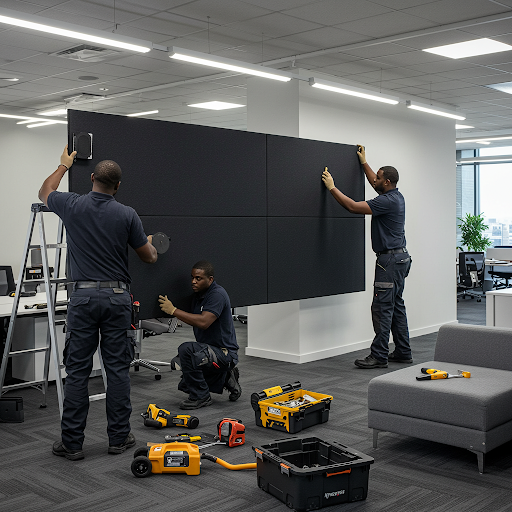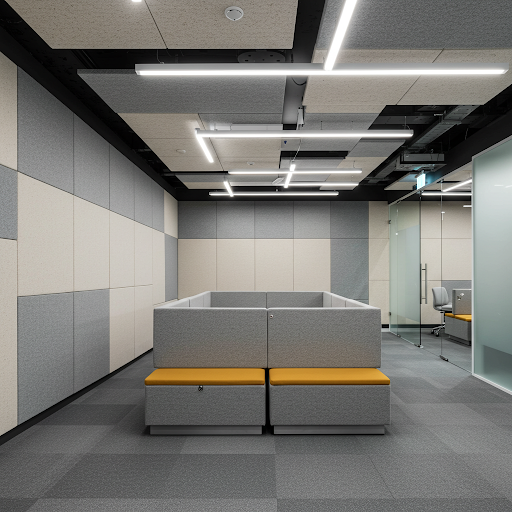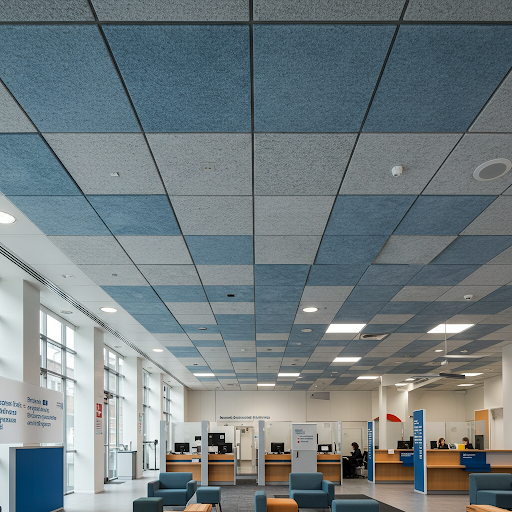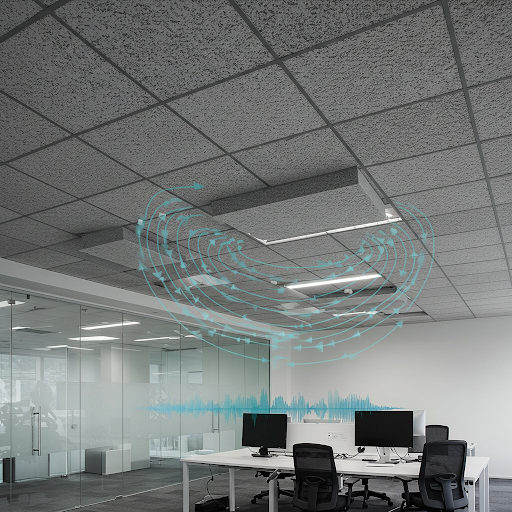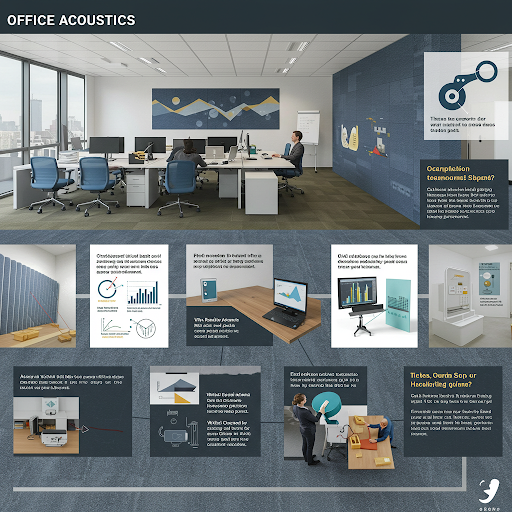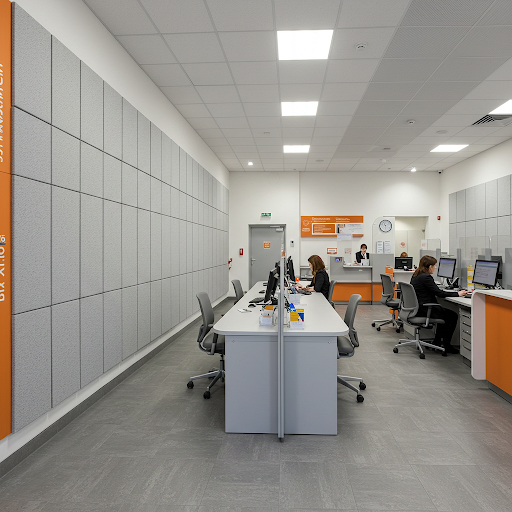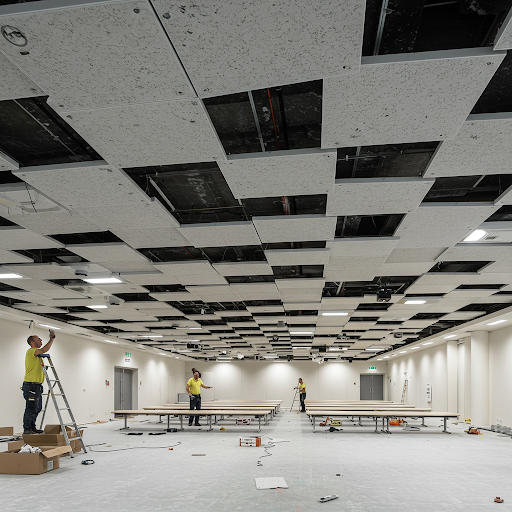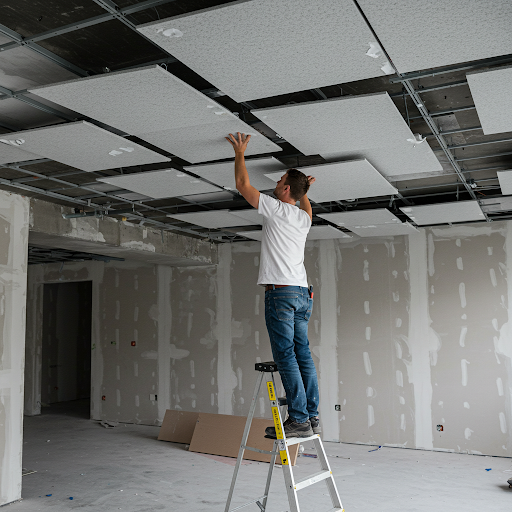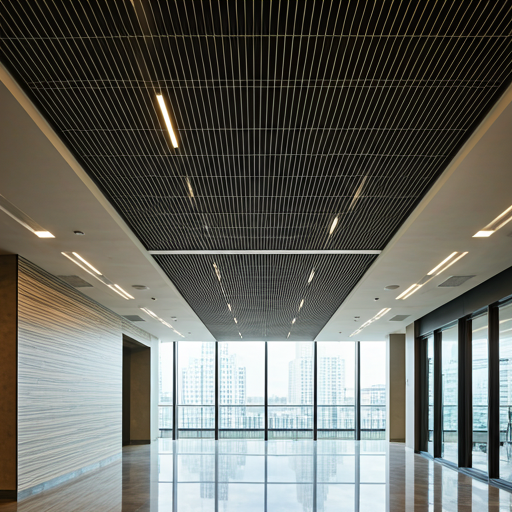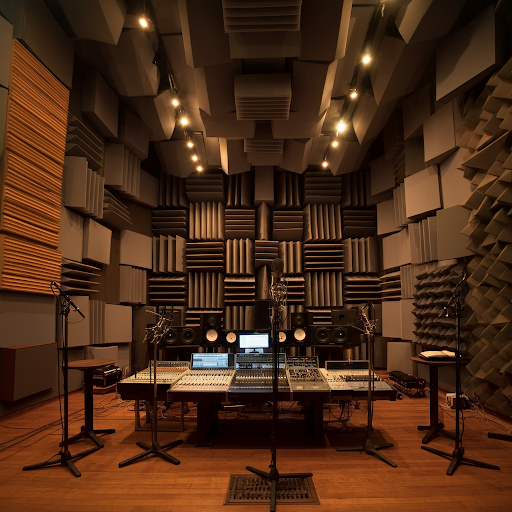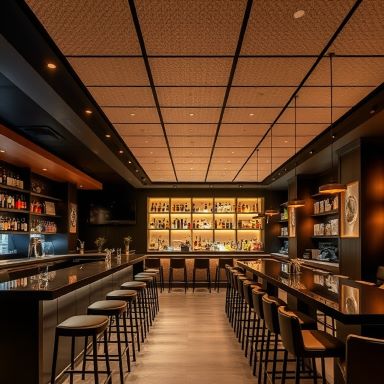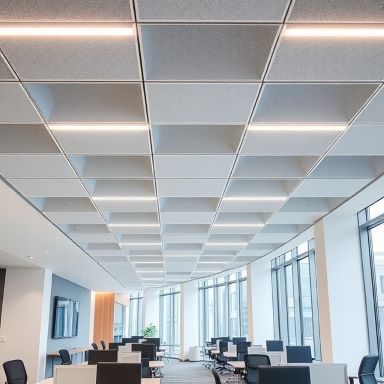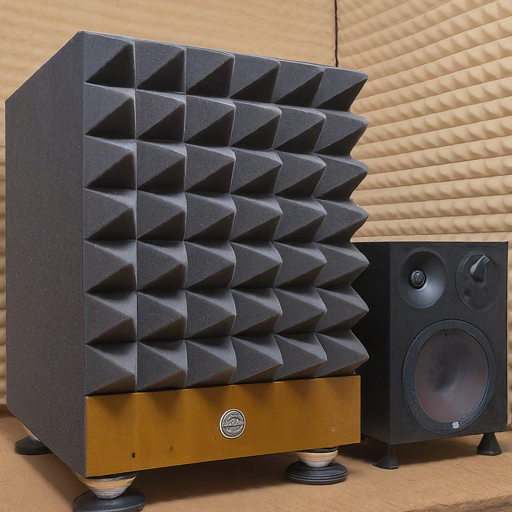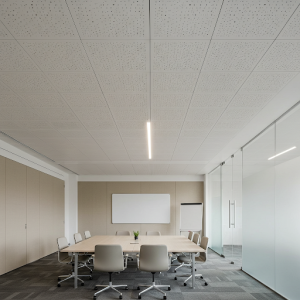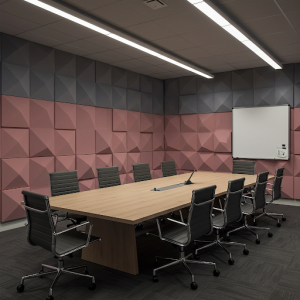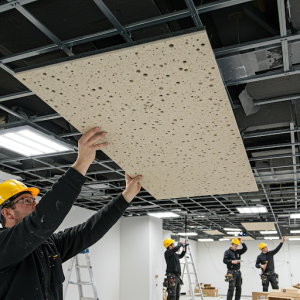Description
Acoustic panels are a crucial element in creating a productive and comfortable meeting room environment. One of the factors that can influence the success of a meeting room is the perceived acoustic comfort within the room. Active participation in meetings in non-acoustically corrected environments inevitably leads to mental fatigue, with a consequent decrease in concentration. In the acoustic design of a meeting room, careful attention must be paid to the selection of finishing materials to ensure low reverberation times appropriate for the activity being conducted, minimizing acoustic disturbances from speech or the playback of audiovisual material.

Conference and meeting rooms are spaces designed for live presentations, where sound clarity is paramount. Acoustic panels play an essential role in ensuring that sound reaches the audience cleanly and without interference. By reducing echoes and reverberations, these panels ensure that every word, note, or sound effect is heard clearly, allowing the audience to fully connect with the speaker.
Acoustic treatment of the meeting room is important, as 90% of the quality of the sound depends on it. Even the most expensive microphones or speakers will not allow you to achieve purity of sound if the room is not prepared for professional acoustics.
With poor sound insulation, vibrations, and city noises will be heard in the room in any case. Acoustic wall panels are the most effective material that helps to achieve the necessary acoustic comfort.
Regulations
In Kenya, meeting room noise control is primarily governed by the Environmental Management and Coordination (Noise and Excessive Vibration Pollution) (Control) Regulations, 2009. These regulations, enforced by the National Environment Management Authority (NEMA) and increasingly by county governments like Nairobi City County, aim to protect public health and the environment by setting permissible noise levels for various zones and activities.
For conferences, organizers are expected to obtain a noise permit from NEMA if amplified sound is anticipated to exceed permissible levels. The application requires details of the event, noise type, duration, and mitigation measures. Nairobi County has been actively enforcing these regulations, particularly concerning noise from entertainment venues, and these enforcements would likely extend to conferences producing significant noise. Organizers must ensure their event does not generate “loud, unreasonable, unnecessary or unusual noise” that disturbs the comfort, repose, health, or safety of others.
What types of noise are there?
Noise is the vibration of particles caused by changes in frequency and amplitude. Acoustic panels help reduce particle vibrations. Types of noise:
Impact noise
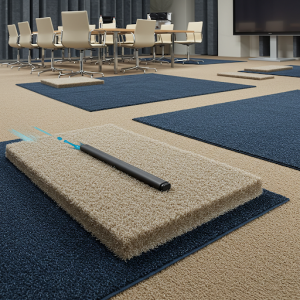
Occurs due to mechanical impact on the foundation, walls, or ceilings. It’s important to clarify that acoustic panels primarily address airborne sound, not impact noise. Impact noise, like footsteps or objects hitting surfaces, travels structurally. However, acoustic panels can contribute to mitigating the resulting airborne noise from those impacts.
Airborne noise
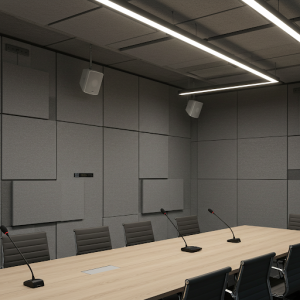
Occurs due to vibrations of sound waves. For example, a dog barking, neighbors talking. Acoustic panels effectively reduce airborne noise in meeting rooms by absorbing sound waves, minimizing reflections, and controlling reverberation.
Strategically placed wall and ceiling panels, especially those with porous materials like foam or mineral fiber, trap sound energy, preventing it from bouncing around the room. This lowers the overall noise level, improves speech clarity, and creates a more comfortable environment. Panel density, thickness, and surface treatment influence their absorption efficiency. Optimizing panel coverage based on room dimensions and noise sources is crucial for achieving desired acoustic improvements.
Structural noise

Acoustic panels primarily target airborne noise, not structural noise. Structural noise, like vibrations traveling through walls or floors, requires different solutions. But acoustic panels can indirectly help by reducing the reverberation of airborne noise caused by structural vibrations.
When setting up a meeting room, it is important to provide maximum protection from all possible types of noise, since even small interferences that get into the meeting room reduce its quality.
Installation of professional soundproofing material – acoustic panels – will solve the problem of excess noise and will allow you to achieve sound clarity.
Types of acoustic panels for meeting room soundproofing
There is a wide range of acoustic panels:
Multilayer acoustic panels
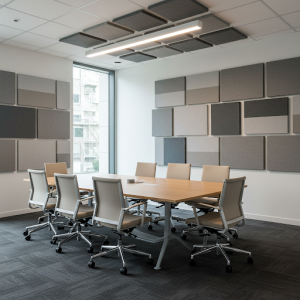
Multi-layer acoustic panels consist of 2-3 layers – cellular coating, base, and partition. Each layer dampens the sound wave. The porous layer attenuates most of the noise.
Installing multilayer acoustic panels in a meeting room involves planning and precision. First, measure the room and determine panel placement, focusing on reflection points. Mark these locations on the walls. Apply adhesive or use mounting hardware according to panel specifications. For larger panels, use a level to ensure straight alignment.
Perforated mineral fiber material
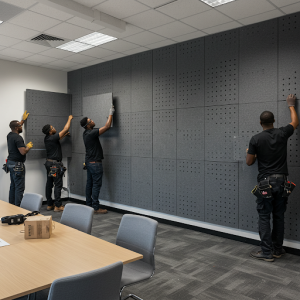
The canvas can be painted. The products are distinguished by their aesthetic appearance and are suitable for installation in any room. To install perforated mineral fiber acoustic panels, first measure and mark the panel layout on the walls or ceiling. Install a grid system (T-bar or similar) according to the manufacturer’s instructions, ensuring it’s level and secure.
Wear appropriate safety gear, as mineral fiber can be irritating. Carefully lift and insert the panels into the grid, ensuring a snug fit. Use edge trim for a clean finish. For ceiling installations, consider using safety wires for added support. Verify the panel alignment and adjust as needed. Finally, test the room’s acoustics to confirm effectiveness.
Foam acoustic wall panels
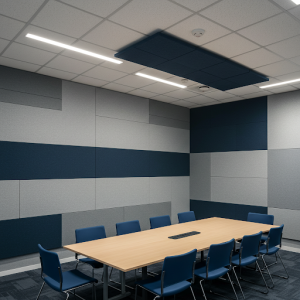
Effectively reduce noise and reduce the echo effect. Installing foam acoustic wall panels is straightforward. First, clean the wall surface. Next, plan your layout. For spray adhesive, apply it to both the wall and the panel back, then press firmly. For adhesive tabs or double-sided tape, apply them to the panel corners and center. Position the panel on the wall and apply pressure. For larger panels, use more adhesive points. Ensure panels are level and aligned. Leave a small gap between panels for a clean look. Allow the adhesive to cure fully before use.
MDF panels are made from wood
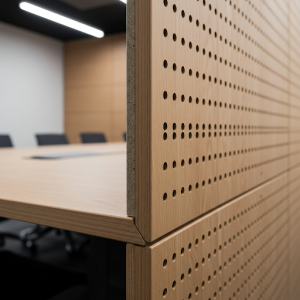
MDF (Medium Density Fiberboard) acoustic panels offer a versatile and cost-effective solution for sound absorption.
They’re typically perforated or slotted to enhance their acoustic properties. Installation involves measuring and marking the wall or ceiling, followed by securing a framework or using adhesive. Due to MDF’s weight, proper support is crucial. Ensure panels are level and aligned for a professional finish. Various finishes, from veneers to laminates, allow for aesthetic customization. While effective at reducing reverberation, they might not be as efficient as specialized acoustic materials in demanding environments.
Glass wool lining acoustic panels for a meeting room
Glass wool lining in acoustic panels offers excellent sound absorption, ideal for meeting rooms. Enclose glass wool within a rigid frame (wood or metal) for structural integrity. Cover the front with acoustically transparent fabric to maintain aesthetics and prevent fiber release. Ensure the panel’s back is sealed to maximize absorption. Install these panels on walls and ceilings at reflection points to reduce reverberation and improve speech clarity. Consider varying panel thickness and placement for balanced sound control across frequencies. Properly installed glass wool panels create a comfortable, distraction-free meeting environment.
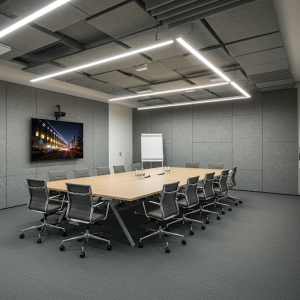
Wallpaper Kenya sound engineers will tell you which material is best to choose for your premises.
How acoustic panels work
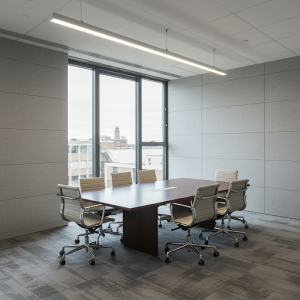
Acoustic panels for meeting rooms effectively absorb sounds due to their multilayer structure. Each layer has sound-absorbing properties. Each panel most often consists of 3 layers: decorative, porous, and durable base. The porous layer dampens most of the shock wave spectrum, and the base is responsible for damping the rest of the noise wave.
When choosing acoustic wall panels, you need to pay attention to the type of premises, as depending on where soundproofing is required, a canvas with different technical characteristics will be needed. Additionally, consider the material characteristics; acoustic panels for a meeting room can be 1-3 layers. And if the room is small, it is recommended to use single-layer panels. Since installing multi-layer ones, the room visually decreases due to the thickness of the panel.
Where to install acoustic panels?
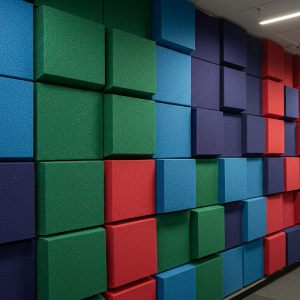
The installation location of acoustic wall panels in the meeting room, studio, office, or industrial space will vary. It depends on the sound source, installation purpose, and material purpose. If the panel is not mounted on the entire wall, its location affects the quality of sound insulation.
Acoustic panels for an office are installed depending on the height at which the sound is generated. Most often, they are fixed at a height of 120-150 cm. Acoustic panels are mounted relative to where the speaker is located. Rectangular acoustic panels are placed on the wall at a height of 120 cm in the center of the wall at the point of sound reflection. If it is difficult to make calculations, it is recommended to cover the entire wall with soundproofing material.
Reflection points
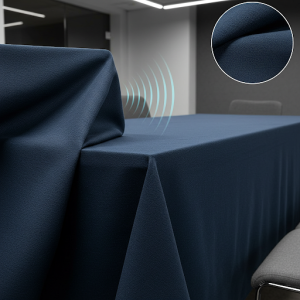
When installing decorative acoustic panels for a meeting room, you need to consider that the speakers work simultaneously. And their sound is directed at the listeners from different sides. In this case, the canvas is installed on the back wall. If a subwoofer is added to the speakers, then it is necessary to glue not only the acoustic panels but also a bass trap that works at low frequencies. It is usually placed in the corners of the room.
For the sound from the speakers to be of high quality, it is necessary to think about how the movement of sound waves that come out of the speaker and are reflected from the wall or ceiling after a person hears them is carried out. Acoustic panels for the walls must be installed at the points of sound reflection.
Depending on the number of speakers, it will be more difficult to track reflection points. We recommend using the services of specialists and performing an acoustic calculation. This will allow you to receive effective data on the acoustic situation and ways to solve it from professionals who will take into account all the details and conditions in your room.
How many acoustic panels are needed for a meeting room?
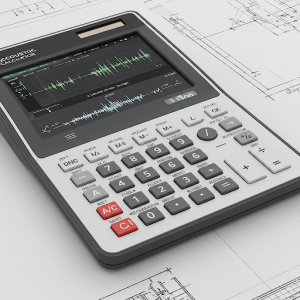
The number of decorative acoustic panels depends on the size of the material and the purpose of installation. For equipping a home theater or amateur recording studio, you can be content with a canvas installed in certain places, in sound reflection zones. If studio-quality sound or music recording is required, we recommend using studio acoustic panels and covering most of the wall with them. If in an office, only 5-10% of the wall covered with canvas is enough to protect against unnecessary sounds, then in a home recording studio, to achieve an acoustic effect, 15-30% of the walls will need to be sealed with office acoustic panels.
How does the size and shape of the room affect the installation of acoustic panels?
When installing acoustic panels for walls, it is necessary to take into account the architectural features of the room – shape and size. The most common shape of the room is square or rectangular. In this case, you can glue the acoustic panels at a certain interval along the entire perimeter of the room.
In a long or wide meeting room, the sound wave has more time to travel. This means that to absorb the sound, you will need to install acoustic panels with a larger area on the wall opposite the sound source so that the material completely dampens the sound wave.
Installing acoustic panels on the meeting room ceiling
We recommend that you make an acoustic calculation to determine the thickness of the canvas and the number of acoustic ceiling panels and wall panels required to achieve the expected soundproofing effect.
For acoustic calculation, it is necessary to obtain the area of the premises and architectural features, availability of ventilation systems and heating pipes, location of doors and windows, the quality of finishing materials used in finishing works, and features of acoustic equipment.
Based on this data, the computer program calculates and gives recommendations on what acoustic wall panels to buy to achieve the desired sound control. The advantage of acoustic calculation is that it eliminates the human factor. And there will be no error in the results. This will allow you to save money by immediately buying exactly those materials that solve the problem of poor sound.
Wallpaper Kenya Specialists are ready to answer any questions and select the glue for fixing the canvas in the room.
Installation Features
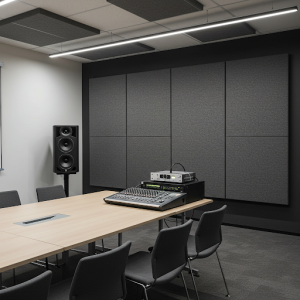
To achieve the required sound quality, it is recommended to install professional-quality conference room acoustic panels. They are installed in those areas where the sound wave will pass. It is not always necessary to install them over the entire surface of the room. Also, acoustic panels should be installed opposite the meeting room’s sound equipment.
To obtain the desired effect, select the points where the speaker finds its extreme expression (we are talking about the initial and final positions). To ensure maximum control over the quality of the sound, it is necessary to install acoustic panels on the wall opposite the speakers. In this case, you should choose the material of maximum thickness to reduce the level of comb filtering coming from the speakers and occurring at low frequencies.
We recommend not only choosing acoustic panels for the meeting room walls. But also installing bass traps, which should be placed in the corners of the room. It is advisable to do this along the entire height, as well as between the ceiling and the wall.
